Have you ever wondered why a simple walk, stretch, or deep breath can instantly make you feel lighter—both physically and emotionally? In today’s digitally noisy environment, managing stress is not a choice but a must for your health.
Physical strategies, such as mindful movement and deep breathing, serve as effective antidotes to tension by retraining the nervous system to manage stress resiliently. These accessible methods, which require no special equipment, can include simple activities like stretching or taking a brisk walk.
According to Harvard Health, exercise is effective in managing stress, as regular motion helps diffuse pent-up tension.
The adaptability of these strategies allows anyone to incorporate them into their daily routine, leading to enhanced emotional endurance, better sleep quality, and overall vitality. Instead of avoiding stress, these approaches transform how the body responds to it.
This guide highlights various techniques—like cardio workouts, breathing exercises, and stretching routines—that help in managing stress and improving overall well-being. They activate the parasympathetic nervous system, promoting relaxation and mental clarity.
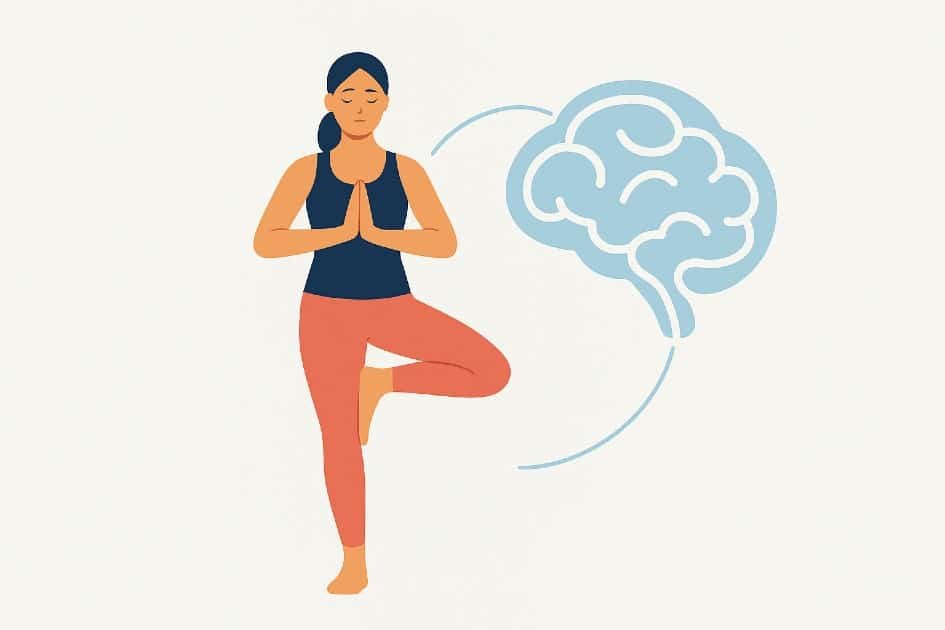
How Your Body and Mind Work Together
Stress impacts both mental and physical health, and effective management involves recognizing this connection. Small, intentional actions can enhance emotional resilience and overall well-being.
How Your Body Health Shapes Stress
Physical health and mental well-being are interconnected; poor physical health can heighten stress levels, while good health enhances resilience.
Factors such as sleep deprivation, unhealthy diet, and lack of exercise can increase cortisol levels, contributing to chronic fatigue, low energy, and irritability, which complicates stress management.
How to improve:
- Do moderate cardio, like brisk walking or cycling, to ease stress and calm your mind.
- Eat a balanced diet with protein, healthy fats, and fiber to keep your mood steady and energy strong.
- Go to bed and wake up at the same time each day and aim for 7–9 hours of sleep to keep your body and mind healthy.
I am lighter and my mind clears up when I take a short walk or do a quick workout. Even 15 minutes of movement lifts my mood and helps me manage stress better.
How Your Mind and Body Share Stress
Stress activates the sympathetic nervous system in response to perceived threats, leading to physiological effects such as faster heartbeats, tense muscles, and shallow breathing. Prolonged stress can negatively impact digestion, immunity, and cognitive function.
Stress is often perceived solely as a mental issue, leading to the neglect of physical signals, which perpetuates the stress cycle and complicates its resolution.
How to improve:
- Pay attention to your body, spot any tightness, and relax those areas on purpose.
- Try progressive muscle relaxation to calm your body and switch off stress mode in your nervous system.
- Try yoga or tai chi to bring balance to your mind and body.
When I pause each day to notice my shoulders and jaw, I release tension and feel calmer. This simple habit reminds me how closely my body and mind are connected.
Movement Lifts Your Mood Fast
Movement serves as emotional medicine by triggering endorphin release, improving mood rapidly, and interrupting stress responses for mental reset.
Movement can effectively relieve stress, contrary to the belief that it necessitates lengthy workouts or complicated routines.
How to improve:
- Take a quick stand and stretch every hour to ease built-up tension.
- Do quick bursts of movement, like jumping jacks or climbing stairs, to boost energy and ease stress.
- Try playful moves like dancing or backyard games—fun makes your body release more endorphins.
On my lunch break, I swapped phone scrolling for a quick 10-minute walk around the block. I felt my stress drop and my mind clear instantly.

Exercise as a Natural Stress Reliever
Exercise serves as an effective method to manage stress and by inducing chemical changes in the brain that enhance mood, boost energy, and soothe the nervous system.
Recognizing how exercise functions and implementing small, actionable steps can make stress relief easier and more sustainable.
Cardio Workouts That Melt Stress Away
Why it matters:
Cardiovascular exercises such as running, brisk walking, and cycling elevate heart rate and release endorphins, which alleviate stress hormones, reduce anxiety, and enhance sleep quality.
Additionally, cardio activities improve blood circulation to the brain, resulting in better focus and mental clarity.
How to do it:
- Begin with 15–20 minutes of fast walking or cycling each day. Slowly build up to 30–45 minutes for better results.
- Do quick bursts of intense exercise, then switch to a steady pace to boost endorphins.
- Choose activities you love, like dancing or swimming, to stay active and enjoy every move.
- Use a fitness app or wearable to monitor your workouts and keep motivation high.
I find that just 5 minutes of moving—like climbing stairs or doing jumping jacks—helps me shake off stress fast.
Strength Training Builds Inner and Outer Strength
Why it matters:
Strength training enhances not only physical appearance but also mood, self-confidence, and stress resilience.
It helps regulate cortisol levels and promotes efficient recovery, leading to improved mental well-being and a sense of control amid life’s challenges.
How to do it:
- Strengthen your muscles with free weights, resistance bands, or bodyweight moves like squats, lunges, and push-ups.
- Do 2–3 strength workouts each week, working all major muscles.
- Use the correct form to stay safe and get the most from every exercise.
- Use compound exercises that work several muscles at once for faster, stronger results.
- Slowly add more weight or resistance to push your muscles and help them grow stronger.
I started using this resistance band set at home, and it is perfect for beginners like me to build strength quickly.
Low-Impact Exercises for Gentle Stress Reduction
Why it matters:
Low-impact exercises like yoga, tai chi, and swimming offer gentle movement that alleviates tension and minimizes joint stress. These activities integrate controlled motion with deep breathing, effectively calming the nervous system and managing stress.
How to do it:
- Start your day with 15–30 minutes of yoga or tai chi at home using online videos.
- Move slowly and with intention, matching each action with mindful breathing.
- Swim or do water aerobics for heart-healthy exercise that is easy on your joints.
- Add quick stretches to your day to ease tight muscles from sitting too long.

Easy Breathing Tricks That Calm Your Mind
Stress can be overwhelming, but controlling your breath is an effective method to manage it, signaling your nervous system to relax. Practical breathing techniques can help you regain calm and focus on any time.
Deep Diaphragmatic Breathing
Why it matters:
Shallow breathing can keep the body in “fight or flight” mode, whereas diaphragmatic breathing utilizes full lung capacity, delivering oxygen deep into the body.
This technique helps reduce cortisol, manage stress, enhances mental clarity, lowers blood pressure, and alleviates tension in the chest and shoulders.
How to do it:
- Sit or lie comfortably, placing one hand on your chest and the other on your belly.
- Breathe in through your nose for four counts, letting your belly expand while your chest stays still.
- Pause your breath for a quick 1–2 counts.
- Breathe out through your mouth for six counts, letting your belly relax.
- Breathe deeply 5–10 times, feeling your belly rise and fall with each breath.
- Use daily practice, especially before stressful moments, to build an automatic calm response.
Box Breathing
Why it matters:
Box breathing helps balance oxygen and carbon dioxide in the body, calming the nervous system. It enhances mental focus and reduces anxiety, making it useful to manage stress in various settings.
How to do it:
- Breathe in through your nose for four seconds.
- Inhale deeply and hold your breath for 4 seconds.
- Exhale through your mouth, taking four slow counts.
- Hold the position for 4 seconds, then repeat.
- Hold the position for 4 seconds, then repeat.
I adjust the counts to what feels right, keeping both sides even to stay fully relaxed.
4-7-8 Breathing
Why it matters:
This technique activates the parasympathetic nervous system, slowing the heart rate and inducing deep calm, making it effective for managing stress before sleep or after emotionally draining moments.
How to do it:
- Breathe gently through your nose for four counts.
- Pause your breath for 7 seconds, letting oxygen flow through your body.
- Breathe out strongly through your mouth for 8 seconds.
- Start with four rounds and add more gradually until you reach eight.
- Try this method whenever your mind feels tense or thoughts race.
Calm Your Mind with Alternate Nostril Breathing
Why it matters:
This yogic technique balances the brain’s hemispheres, promoting mental equilibrium. It effectively reduces anxiety, enhances concentration, and aids me to manage stress before important tasks or exams.
How to do it:
- Sit upright with a straight spine, keeping your shoulders relaxed.
- Block your right nostril with your thumb and take a deep breath through your left nostril.
- Press your left nostril with your ring finger, open your right nostril, and exhale completely.
- Breathe in through your right nostril, pinch it shut, then exhale through your left.
- Continue for 5–10 rounds, keeping your breaths steady and calm.
Resonance Breathing
Why it matters:
Resonance breathing synchronizes heart rate and breathing patterns, promoting a state of calm. It reduces chronic stress symptoms and enhances emotional resilience, making it a vital long-term tool to manage stress.
How to do it:
- Find a quiet spot to sit or lie down and let your body relax.
- Breathe slowly for five to six seconds.
- Breathe out slowly for 5–6 counts, keeping a steady rhythm.
- Spend 10 minutes imagining stress flowing out of your body.
- Listen to soft music or guided audio to relax deeply.

Stretching Builds Flexibility and Eases Stress
Stretching and flexibility exercises are key tools for managing stress, often overlooked despite their effectiveness. They relieve physical tension, calm the mind, improve posture, and boost energy levels.
Understanding the importance of stretching and how to integrate it into your routine can lead to daily stress management.
Morning Stretches to Start Your Day Stress-Free
Why it matters:
Starting your day with stretching enhances muscle and joint function, improves circulation, reduces overnight stiffness, and promotes the natural release of endorphins, which boosts mood.
How to do it:
- Neck Rolls: Gently turn your head in a circle clockwise, then counterclockwise for 30 seconds.
- Cat-Cow Stretch: Get on all fours and slowly arch and round your back with control.
- Side Stretch: Lift your arms overhead and tilt gently to each side for 10–15 seconds.
I stretch barefoot or on a soft surface to keep my body aligned. Using a high-quality yoga mat makes my morning stretches more comfortable and effective
Yoga Poses Specifically for Stress Relief
Why it matters:
Yoga combines stretching, controlled breathing, and mindfulness, effectively reducing stress. Certain poses activate the parasympathetic nervous system, lowering stress hormones, while sustained stretches enhance flexibility and diminish physical tension that may lead to mental stress.
How to do it:
- Child’s Pose (Balasana): Kneel, reach forward with arms, and stretch. Hold for 1–2 minutes to relax muscles and improve flexibility.
- Seated Forward Fold (Paschimottanasana): Sit with legs straight, lean forward from your hips, and take deep, steady breaths.
- Reclined Spinal Twist: Lie on your back and slowly twist your knees side to side.
I slow my breath, inhaling deeply and exhaling fully to calm my mind and body.
Stretching Breaks Ease Work Stress
Why it matters:
Sedentary work contributes to tightness in hips, shoulders, and lower back, potentially heightening stress perception.
Implementing micro-breaks can alleviate muscle fatigue and mental burnout. Regular stretching breaks may help reduce cortisol levels throughout the day.
How to do it:
- Shoulder Shrugs and Rolls: Raise your shoulders toward your ears and roll them backward and forward ten times.
- Standing Hamstring Stretch: Step forward, bend at your hips, and keep your back straight.
- Seated Twist: Sit upright, gently twist your torso to one side, hold for 10 seconds, then switch sides.
I set a timer every hour to stretch, even for just 2–3 minutes. Using a posture chair or a standing desk makes my breaks even more effective.
Using Dynamic Stretching Before Physical Activity
Why it matters:
Dynamic stretching actively warms muscles, enhances mobility, and reduces stress-related tension, thereby preventing exercise-related injuries.
Additionally, it reinforces the mind-body connection, which is crucial to effectively manage stress.
How to do it:
- Leg Swings: Swing each leg forward and back 10–15 times.
- Arm Circles: Swing your arms in big circles, widening the motion as you go.
- Hip Openers: Stand tall and circle your hips slowly to loosen muscles and improve flexibility.
I move with purpose, controlling each motion instead of rushing.
Nighttime Stretches for Relaxation and Better Sleep
Why it matters:
Evening stretches help reduce mental tension and muscle tightness from the day, leading to improved sleep quality, which is essential to effectively manage stress.
How to do it:
- Supine Hamstring Stretch: Lie on your back and use a strap or towel to gently pull one knee toward your chest.
- Neck and Shoulder Stretch: Tilt your head toward your shoulder and hold for 15 seconds on each side.
- Butterfly Stretch: Sit, bring the soles of your feet together, and gently press your knees down.
I dim the lights and stretch while taking deep breaths to fully relax my body and mind.
Combining Stretching With Mindful Breathing
Why it matters:
Mindful stretching combined with synchronized breathing reduces muscle tension, enhances body awareness and oxygen flow, lowers stress hormones, and helps prevent escalating tension.
How to do it:
- Inhale deeply and extend your stretch.
- Exhale completely and relax deeper into the stretch.
- Notice the feelings in your muscles, joints, and nearby tissues.
I use a guided stretching app or a short timer to keep my practice focused. Mindfulness and breathing apps help me follow routines correctly and stay calm.
Easy Stretches Improve Flexibility and Relaxes Mind
Why it matters:
Foam rollers, resistance bands, and yoga blocks enhance stretching by relieving muscle knots, ensuring better form, and allowing longer hold times for stress relief.
How to do it:
- Foam Roller: Slowly roll each muscle, pausing on sore spots to ease tension.
- Resistance Bands: Gently help to deepen hamstring and shoulder stretches
- Yoga Blocks: Helps you stay steady in tough poses while easing strain.
I begin with 5–10 minutes of tool-assisted stretches and slowly add more time as my body warms up.
Stretching Helps You Stay Calm and Relaxed
Why it matters:
Stretching is most effective when used alongside other physical methods such as exercise, walking, or massage.
A holistic approach that addresses various stress triggers leads to enduring relief, turning minor daily practices into significant tools for managing stress.
How to do it:
- Stretch for 10–15 minutes each morning, afternoon, and evening to boost energy and ease tension.
- Combine stretches with deep breaths, yoga, or gentle cardio to relax muscles and boost energy.
- Tune in to your body and adjust your effort to match your energy and comfort.
I ease tension and clear my mind by stretching in the morning, doing short yoga poses, taking quick work breaks, and practicing calm bedtime routines.
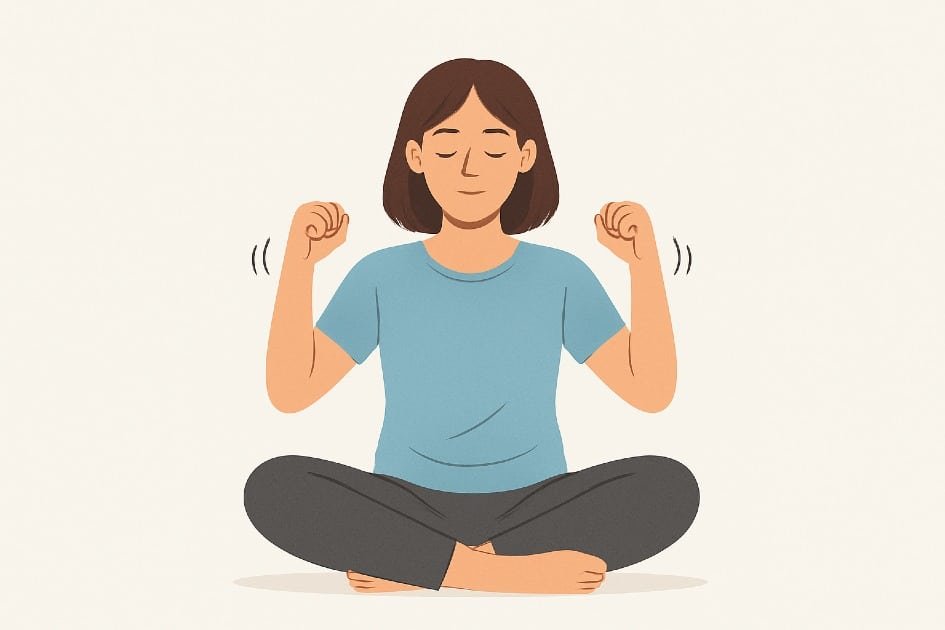
Ease Tension with Muscle Relaxation
Stress can be managed effectively using Progressive Muscle Relaxation (PMR), a strategy that helps release tension, enhance focus, and regain calm.
Understanding Progressive Muscle Relaxation
Why it matters:
Progressive Muscle Relaxation addresses physical stress symptoms by helping individuals consciously relax their muscles, which may have tensed up unnoticed.
This practice can alleviate headaches, fatigue, and anxiety by signaling the nervous system to calm down, thereby lessening the body’s stress response.
How to do it:
- Find a calm spot and sit or lie down where you feel at ease.
- Shut your eyes and notice each breath.
- Begin at your feet and tighten each muscle for 5–10 seconds.
- Release the tension slowly and feel your body relax.
- Work slowly from your calves to thighs, then to your core, arms, shoulders, neck, and face.
I use this method to teach my body the difference between being tense and being relaxed, and it helps me manage stress better every day.
Ground Your Calm Through Feet and Legs
Why it matters:
Your feet and calves can store tension due to everyday activities or tight footwear. Releasing this tension enhances circulation and alleviates fatigue, fostering a feeling of calmness.
How to do it:
- Curl your toes and hold for 5–10 seconds, then relax.
- Lift your heels up and squeeze your calves. Hold the squeeze.
- Let your legs sink and notice their weight.
- Do it twice for best results.
I use this simple routine to start my day, and it makes stepping into a busy schedule feel lighter and stress-free.
Release Tension in Hips and Thighs
Why it matters:
Hips and thighs accumulate stress from prolonged sitting and emotional tension, and releasing this tension can improve posture and alleviate lower back strain.
How to do it:
- Tighten your thigh muscles as you breathe in.
- Hold tight and feel your muscles work.
- Breathe out slowly as you let the muscle relax.
- Notice the warmth and ease flowing through your legs.
I release stress from my core, boosting my energy and focus.
Release Stress from Your Belly
Why it matters:
The abdomen tightens with emotional or psychological stress and relaxing can alleviate digestive discomfort and anxiety symptoms.
How to do it:
- Pull your belly button toward your spine to engage your core muscles.
- Pause and keep the position for 5–10 seconds.
- Exhale slowly and feel your torso relax.
- Pair with slow breaths to boost calm and relaxation.
I focus on my core to strengthen the mind-body link, helping me relieve stress for good.
Release Tension in Arms and Hands
Why it matters:
Relieving tension in hands and arms, caused by typing and lifting, can reduce hand cramps, shoulder stiffness, and irritability.
How to do it:
- Clench your fist tightly, hold for a moment, then release slowly.
- Tighten your biceps and hold firmly.
- Let go slowly and feel the shift from tension to ease.
- Do exercise one arm at a time.
I use this method at my desk to stay calm after repetitive tasks and reduce stress at work.
Ease Tension in Shoulders and Neck
Why it matters:
Neck and shoulder stiffness often indicate chronic stress, and relieving tension in these areas can help prevent headaches and enhance posture.
How to do it:
- Lift your shoulders up to your ears and hold for 5 seconds.
- Exhale gently, letting tension flow out with each breath.
- Tilt your neck side to side to release built-up tension.
- Pair it with deep breathing to ease tension faster.
When I loosen my shoulders and chest, I think more clearly and feel less stress in my body.
Release Face and Jaw Tension Daily
Why it matters:
Facial tension can cause issues such as jaw pain, teeth grinding, and headaches. Relaxing the face promotes overall bodily calmness.
How to do it:
- Gently tighten your jaw, hold for a moment, then relax.
- Tighten your nose and forehead, hold for a moment, then release.
- A soft smile can ease stress and lift your mood.
When stress hits work or home, I refresh my face with this quick routine, it calms me fast and keeps me focused
Sync Breathing with Muscle Relaxation
Why it matters:
Breathing enhances Progressive Muscle Relaxation by lowering cortisol levels and promoting calmness through slow, mindful breaths.
How to do it:
- Breathe in deeply and tighten your muscles, then release to ease stress.
- Breathe out slowly and let your tension go.
- Focus on each breath to stay mindful and calm.
- Work each muscle group again in the same order.
I combine deep breathing with PMR to relax my body and clear my mind.
Build Your Daily PMR Habit
Why it matters:
Consistency in PMR shifts it from a short-term relief method to an effective long-term to manage stress strategy, with as little as 10–15 minutes daily significantly enhancing well-being.
How to do it:
- Set aside daily quiet time, either morning or night, to refresh your mind and reduce stress.
- Follow a guided audio or app for easy, structured sessions.
- Measure your stress before and after seeing real progress.
- Change how long and how often you tense muscles to match your comfort level.
I use a daily routine to manage stress before it manages me.
Blend PMR With Other Stress Methods
Why it matters:
PMR is most effective when integrated with movement, stretching, and mindfulness, leading to improvements in mood, energy, and resilience.
How to do it:
- Combine PMR with gentle yoga or stretching to relax muscles and calm your mind.
- Do progressive muscle relaxation (PMR) after a walk outside to release tension and boost calm.
- Use PMR before bed to relax your body and fall asleep faster.
I use several strategies together to keep my mind and body steady, even when stress hits hard.
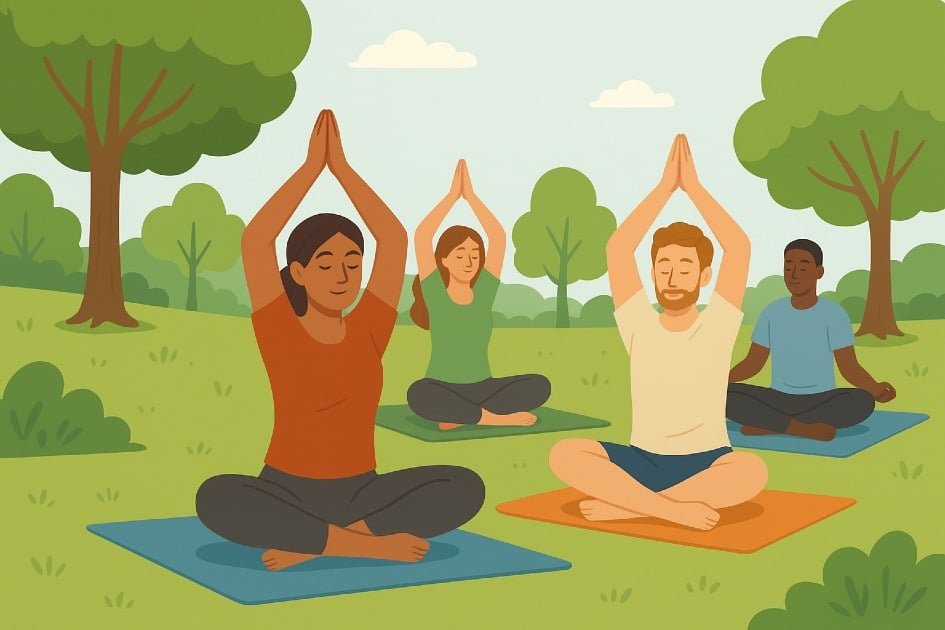
Explore Nature to Beat Stress Naturally
Spending time outdoors is an effective method for managing stress and enhancing mental clarity.
The elements of nature, including fresh air, sunlight, and mild physical activity, help calm the nervous system, providing practical approaches to convert stress into tranquility.
Stroll Through Nature to Boost Calm
Why it matters
Walking in natural environments lowers cortisol levels and boosts endorphin production, leading the brain to transition from stress to a more relaxed and alert state, thereby enhancing focus, mood, and overall wellbeing.
How to do it:
- Take a 20–30 minute walk each day to gently reset your nervous system.
- Observe your surroundings closely, see the colors, feel the textures, and notice the scents around you.
- Change your route to stay curious—new surroundings keep your mind sharp and energized.
- Use a walking app to track your steps and set daily reminders.
- Combine walking with short stretching breaks to relax your body and mind.
I take a 10-minute walk during work breaks, and it keeps my stress under control all day.
Cultivate Calm Through Gardening and Outdoor Fun
Why it matters
Gardening fosters a connection with the earth and offers gentle physical activity while engaging in the senses, reducing stress hormone levels.
The repetitive and purposeful tasks involved, such as planting and pruning, create calming meditative rhythms for the mind.
How to do it:
- Grow herbs or small plants in containers when space is tight.
- Plan weekly tasks, such as watering plants every other day or pruning twice a week.
- Choose ergonomic gardening tools to protect your hands and back while making gardening easier and more fun.
- Engage your senses in the garden: touch the soil, inhale herbs, and observe colorful blooms.
- Spend 5 minutes after gardening noticing how your body relaxes, and your mind clears.
I find that simply tending to a single potted plant calms my mind and melts away stress at home.
Bask in Sunlight and Breathe Fresh Air for Energy
Why it matters:
Sunlight exposure boosts vitamin D production, influencing mood and energy levels. Fresh air enhances cognitive function and reduces muscle and mental tension. Insufficient levels of these elements can lead to increased stress and fatigue.
How to do it:
- Get 15–30 minutes of morning sunlight daily to boost your natural sleep-wake cycle.
- Get sunlight and move—walking or stretching improves blood flow and sharpens your mind.
- Use SPF daily to shield your skin and enjoy the sun safely.
- Breathe deeply outdoors: inhale slowly, pause, then exhale fully to calm your mind.
- Explore nearby parks with a local trail guide to find hidden green spaces.
I open a window and sit in the sun, letting a small dose of nature calm my stress.
Get Active Outdoors and Clear Your Mind
Why it matters:
Exercise outdoors, such as cycling, hiking, or jogging, offers cardiovascular benefits along with the restorative effects of nature.
Engaging in physical activity releases endorphins and serotonin, which help reduce stress while enjoying scenic environments.
How to do it:
- Pick exercises that match your fitness level to stay safe and enjoy progress.
- Use intervals: alternate active movement with slow recovery to stay energized.
- Bring a friend or join an outdoor class—social connections boost emotional support.
- Use a fitness tracker to log outdoor workouts and stay motivated.
- End with 5 minutes of mindful breathing or gentle stretches, noticing the sights and sounds around you.
I feel my stress melt when I exercise outside, even just twice a week—it keeps my tension in check for the long run.
Watch Nature to Calm Your Mind
Why it matters:
Observing nature, even while stationary, promotes mindfulness and helps divert attention from intrusive thoughts, serving as a simple and accessible strategy for managing stress without the need for equipment or a gym.
How to Do It:
- Sit on a bench, rock, or patch of grass and get comfortable outdoors.
- Pay attention to nature—listen to water flow, leaves rustle, and birds sing.
- Write down five things you see around you, notice four things you can touch or feel, listen to three sounds nearby, smell two scents in the air, focus on one thing you can taste.
- Use a 10–15-minute timer to build a steady habit.
- Take a moment after to notice how your body feels—lighter, calmer, or clearer.
I make time for short daily sessions, and they build my emotional strength. Each one helps me stay calm and manage stress better.
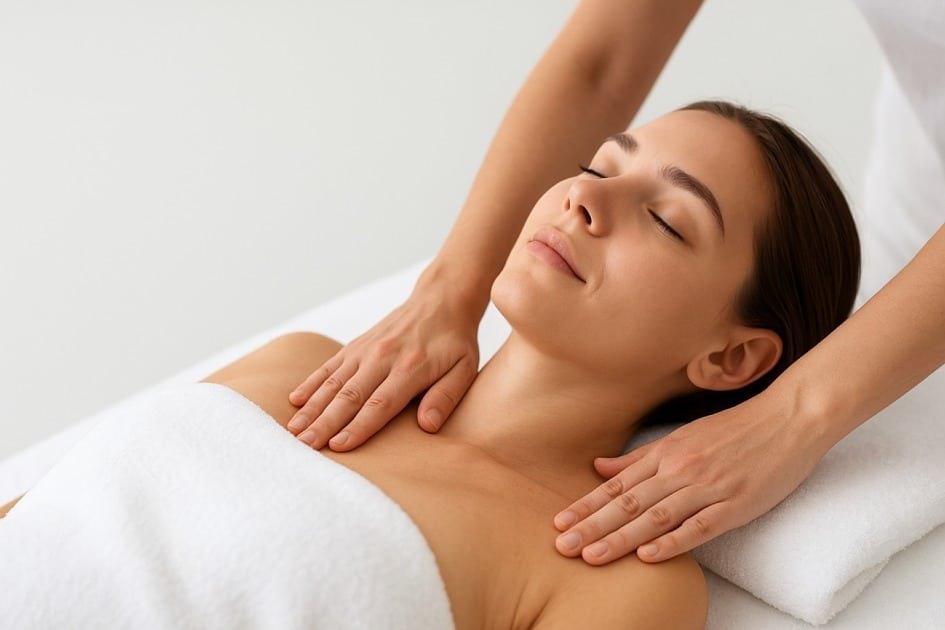
Hands Heal Stress with Massage and Touch
Physical touch is shown to alleviate tension, lower stress hormones, and enhance well-being.
Incorporating massage and touch into daily routines is an effective natural way to manage stress strategies, even for those with busy schedules.
Hands Heal Stress with Simple Self-Massage
Why it matters:
Self-massage alleviates muscle tension and stress by enhancing blood circulation and promoting endorphin release, contributing to relaxation. Even a brief five minutes can effectively aid in manage stress.
How to do it:
- Gently massage your neck, shoulders, and temples with your fingertips.
- Use a massage ball or foam roller to press and roll over tight spots in your calves, back, or arms to release tension.
- Press gently on your hands and feet to release built-up stress.
- Use calming oils or lotions to boost relaxation.
I keep a small hand massage tool on my desk and by the couch. When stress builds up, I grab it for quick relief and feel my tension at ease right away.
Shared Massage Eases Stress Together
Why it matters:
Professional massage offers deeper muscle release and, through physical touch, lowers cortisol while increasing oxytocin, enhancing mood.
Regular sessions can prevent chronic stress buildup, aiding to manage stress for long-term.
How to do it:
- Book a weekly or biweekly massage with a licensed therapist.
- Practice simple partner massage moves for the neck, shoulders, and back to ease stress together.
- Talk openly about pressure and comfort so it works well without causing pain.
- Boost relaxation by pairing massage with soothing music or calming scents.
Release Muscle Tension with Foam Rolling Tools
Why it matters:
Foam rolling effectively alleviates stress and discomfort by targeting deep muscle layers and releasing tight fascia.
Utilizing tools such as massage sticks or percussion massages enhances circulation, reduces soreness, and fosters mental clarity, contributing to manage stress and quicker recovery.
How to do it:
- Stretch and relax key tension spots like your hamstrings, calves, shoulders, and upper back.
- Roll each muscle slowly for 30–60 seconds, pausing on sore spots to ease tension.
- Apply gentle pressure first, then increase slowly to prevent bruising or pain.
- Combine rolling with deep breaths to boost relaxation and stay mindful.
I chose a foam roller that fits my body and daily routine to get the best results.
Use Massage Daily for Lasting Relief
Why it Matters:
Small, consistent practices, such as regular massage and self-care rituals, help manage stress, reinforce the mind-body connection, and promote emotional stability and better sleep, improving long-term resilience.
How to Do It:
- Spend 5–10 minutes each morning or night on self-massage or foam rolling to relax muscles and boost circulation.
- Get a professional massage every month or whenever stress builds.
- Use partner-assisted techniques during everyday bonding moments.
- Place massage tools and oils where you can see them to cue daily use.
I self-massage, work with a partner, or see a professional to release tension. These practices ease my muscles, calm my nerves, lift my mood, and boost my overall well-being.
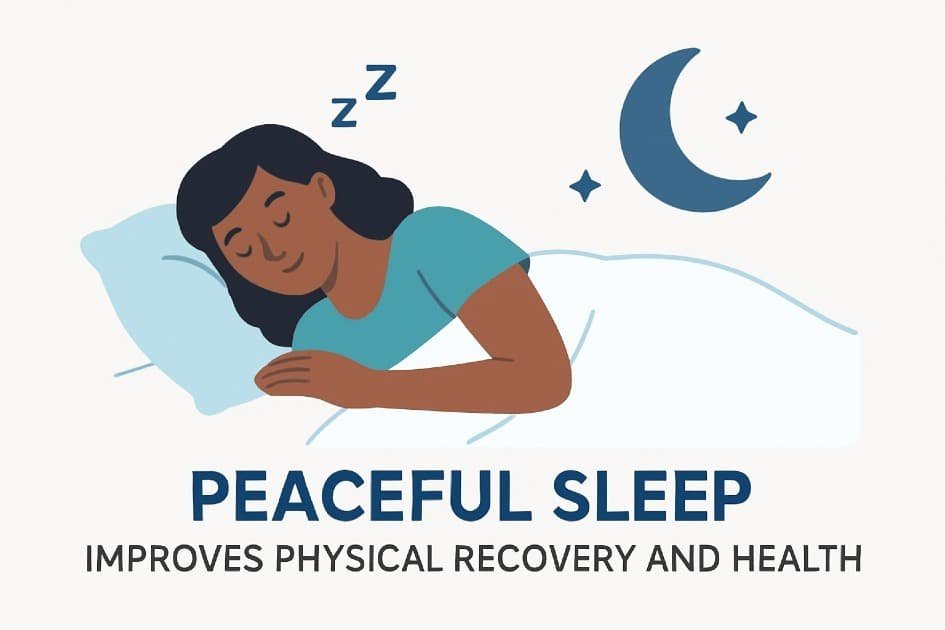
Boost Energy Through Better Sleep
Sleep plays a crucial role in managing stress, with poor sleep exacerbating tension and impairing decision-making.
In contrast, good sleep hygiene and recovery practices can enhance resilience, lower cortisol levels, and improve mood. Practical strategies for optimizing rest are essential for effective recharging.
Rest Fuels Your Body and Mind
Why it matters:
Sleep is essential for resetting the nervous system, repairing muscles, and rebalance stress hormones.
Inadequate quality sleep keeps the body in a heightened stress state, complicating daily stress management.
How to do it:
- Get 7–9 hours of solid sleep each night to boost energy, focus, and overall health.
- Go to bed and wake up at the same time every day, even on weekends, to strengthen your body’s natural clock and improve energy, focus, and mood.
- Use a sleep tracker or app to monitor your sleep and spot any disruptions.
Create a Sleep-Friendly Environment
Why it matters:
Your bedroom environment significantly affects your sleep quality, as factors like light, noise, and temperature can either enhance or hinder you from managing stress.
How to do it:
- Sleep better by keeping your bedroom cool, around 65°F (18°C), to boost deep sleep.
- Block extra light with blackout curtains or a sleep mask to improve rest.
- Block distractions with white noise machines or earplugs to sleep or focus better.
- Use your bed only for sleep—keep work, phones, and screens out.
Limit Stimulants and Nighttime Disruptors
Why it matters:
Caffeine, sugar, and screen light can increase adrenaline and cortisol levels, perpetuating a stress response and impairing stress management.
How to do it:
- Skip caffeine after 2 PM—this includes coffee, tea, and chocolate—to protect your sleep and boost energy naturally.
- Cutting back on alcohol can make you sleepy but harms deep sleep quality.
- Turn off screens an hour before bed to help your brain relax and improve sleep quality.
Pre-Sleep Wind-Down Routine
Why it matters:
A pre-sleep ritual is essential for signaling the brain and body to shift from stress to restoration, playing a crucial role to effectively manage stress.
How to do it:
- Ease muscle tension with simple stretches or yoga moves.
- Try a quick 5–10-minute box breathing exercise to calm your mind and boost focus.
- Writing tomorrow’s tasks clears your mind and keeps worry at bay.
- Use scented candles or essential oils to calm your mind and reduce stress.
Boost Energy with Smart Naps
Why it matters:
A short nap can boost energy, improve focus, and lower stress levels, but excessive sleeping may interfere with nighttime rest.
How to do it:
- Keep naps under 30 minutes and finish before 3 PM for better energy and sleep.
- Rest in a dark, quiet room free from distractions.
- Pair short naps with deep breaths to calm your nervous system fast.
Boost Your Body’s Healing Daily
Why it matters:
Muscles, joints, and connective tissues heal effectively when combined with adequate sleep and focused recovery routines, enhancing the body’s stress management capabilities.
How to do it:
- Use foam rollers or massage tools to ease muscle tightness and boost recovery.
- Do gentle stretches before bed to keep your muscles loose and prevent stiffness.
- Drink enough water to help your cells repair while you sleep.
- Try a warm bath or shower to ease muscles and help you fall asleep faster.
I focus on good sleep and physical recovery to manage stress better. By improving my space and sticking to healthy routines, I boost my body and mind, building lasting strength against daily stress.
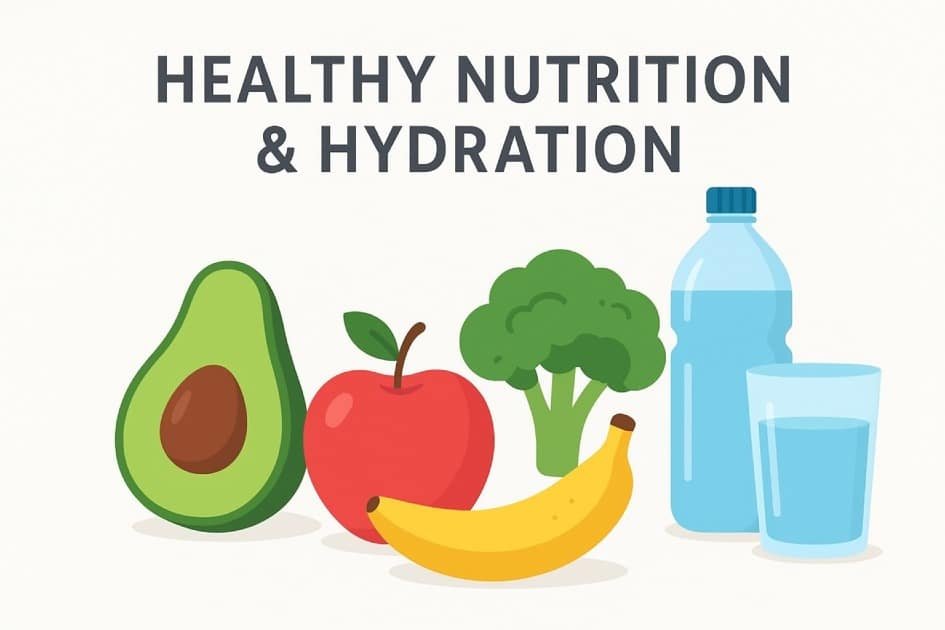
Nutrition and Hydration for Stress Control
Managing stress effectively involves attention to nutrition and hydration, which are crucial for energy, mood stabilization, hormone regulation, and a calm nervous system. These elements are not mere wellness trends; they are practical tools that can be applied daily.
Foods That Naturally Lower Stress Levels
Why it matters:
Nutrient-dense foods aid in regulating cortisol, providing stable energy that diminishes irritability and mental fatigue. Compounds like antioxidants and omega-3s enhance brain function and mood stability.
How to do it:
- Eat complex carbs like oats, quinoa, and sweet potatoes to keep blood sugar steady and moods balanced.
- Boost your calm by eating leafy greens and colorful veggies like spinach, kale, and bell peppers—they supply magnesium and vitamin C to soothe your nerves.
- Eat omega-3 foods like salmon, walnuts, and flaxseeds to lower inflammation and reduce stress.
- Eat fermented foods like yogurt, kimchi, and sauerkraut to boost gut health and help regulate your emotions.
I take a high-quality multivitamin to cover nutrient gaps and help my body handle stress better.
Fuel Your Body and Mind with Water
Why it matters:
Dehydration can resemble stress symptoms such as headaches, fatigue, and irritability. Adequate water intake aids in nutrient transport and toxin removal, which can worsen stress.
Staying properly hydrated supports brain function and mood stability.
How to do it:
- Sip water often. Target 8–10 glasses a day. Carry a reusable bottle for easy access.
- Boost water flavor naturally. Add lemon, cucumber, or mint for tasty, sugar-free hydration.
- Track the amount of water you drink with an app or journal to hit daily hydration goals.
- Sip herbal teas like chamomile or peppermint to calm your nerves and stay hydrated.
Eat at the Right Times to Stay Calm
Why it matters:
Irregular eating can lead to increased blood sugar levels, which may cause anxiety or irritability. Conversely, strategic meal timing helps maintain stable energy levels and lowers overall cortisol levels.
How to do it:
- Eat three balanced meals and two healthy snacks daily to keep your energy steady and avoid crashes.
- Add protein to every meal: eggs, beans, or lean meat keep blood sugar steady and curb stress cravings.
- Skip caffeine and sugar in the evening because they disturb sleep and slow stress recovery.
- Choose nuts, fruit, or Greek yogurt to ease stress without raising blood sugar.
Stress-Fighting Supplements That Work
Why it matters:
Targeted supplementation can enhance mood, energy, and resilience, especially when diet lacks sufficient magnesium, vitamin B, or omega-3s to manage stress effectively.
How to do it:
- Magnesium eases muscle tension and soothes nerves. Magnesium glycinate absorbs best.
- B-Vitamins, especially B6 and B12, boost energy and keep your brain sharp.
- Omega-3s boost brain health and lower inflammation caused by stress.
I start my day with a glass of lemon water and add walnuts and spinach to my lunch. These simple choices keep my energy steady and my mood balanced, making stress easier to handle.
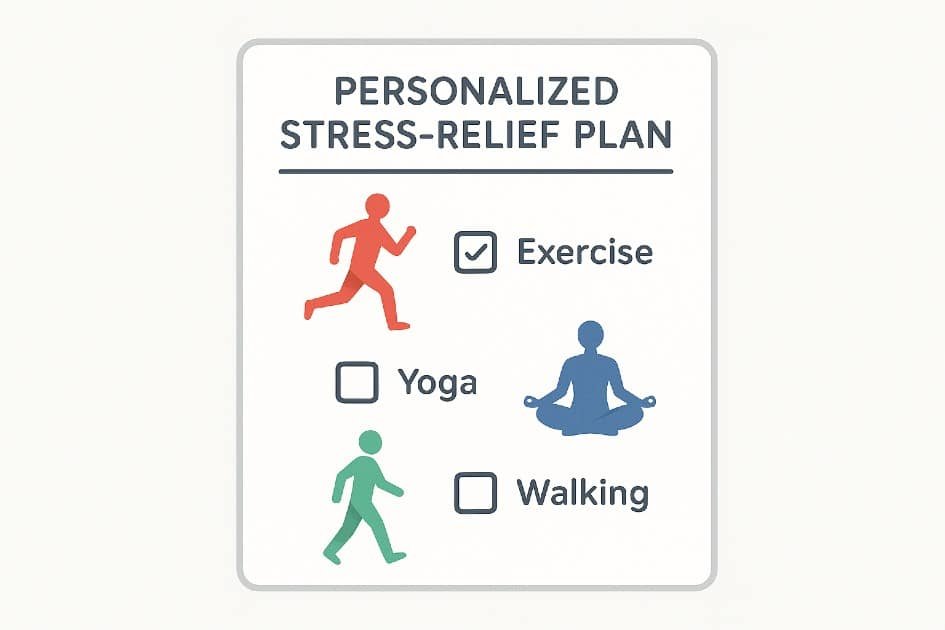
Design Your Own Daily Stress Relief Plan
Stress management is highly individualized; a personalized plan is essential for effective management.
By customizing physical strategies to align with one’s lifestyle, energy level, and preferences, individuals can enhance their chances of achieving long-term success.
Move Your Body, Breathe Deep, and Relax Fully
Why it matters:
The body and mind are interconnected in managing stress; physical movement releases endorphins, breathing exercises soothe the nervous system, and relaxation techniques reduce cortisol levels.
A holistic approach addresses stress from various fronts rather than depending on one method.
How to do it:
- Mix Cardio and Strength: Do 20–30 minutes of moderate cardio—like walking, cycling, or swimming—3–5 times a week. Include 15–20 minutes of strength exercises 2–3 times weekly.
- Daily Breathing Rituals: Start your day with 5–10 minutes of deep belly or box breathing to calm your mind and boost focus.
- End-of-Day Relaxation: Spend 10 minutes stretching, doing yoga, or relaxing your muscles to help your body shift from stress to calm.
Spot Stress Early by Tracking Your Progress
Why it matters:
Stress often develops gradually and can be difficult to recognize.
Monitoring physical and emotional reactions aids in identifying triggers and assessing effective management strategies.
Increased awareness enables proactive adjustments to routines to prevent stress from intensifying.
How to do it:
- Keep a Journal: Track your daily stress, record your workouts, and note how your body and mind respond.
- Use Technology: Fitness trackers track your heart rate, sleep, and daily activity to show how your body handles stress.
- Reflect Weekly: Check your notes each Sunday. Spot when stress peaks and which actions helped most.
Tune Your Day to Match Energy and Mood
Why it matters:
Stress management is dynamic, with energy levels varying; inappropriate exercise intensity can heighten stress instead of alleviating it. Adapting activities to one’s mood promotes consistency and avoids burnout.
How to do it:
- Morning Check-In: Check your energy and mood, then pick an activity that fits how you feel.
- Flexible Exercise Plan: When energy is low, choose a gentle walk, stretching, or light yoga instead of intense exercise.
- Listen to Your Body: If a method tires you more than it calms you, try a different approach or rest.
Blend Movement and Mindfulness for Strength
Why it matters:
Physical movement mitigates physiological stress but combining it with mindfulness improves mental resilience.
Mindfulness enhances self-awareness, enabling a more thoughtful response to stress instead of impulsive reactions.
How to do it:
- Mindful Walking: Notice the feeling of each step and your breath as you walk, staying fully present in the movement.
- Integrate Meditation with Stretching: Finish yoga or stretching with 2–5 minutes of quiet reflection to calm your mind and body.
- Affirmations and Positive Cues: Link each exercise with positive thought to boost calm and focus.
Recap: Moving Forward with Stress-Free Living
Imagine waking up each day feeling lighter and in control of your mind and body.
This can be achieved by using physical strategies to manage stress, such as brisk walks, deep-breathing routines, and mindful activities.
These strategies enhance mental clarity and emotional resilience, equipping you to navigate life’s demands effectively.
Incorporating movement, mindful breathing, and stretching creates a personal blueprint for managing stress without needing special equipment.
Regular physical activity, such as brisk walking, yoga, or tai chi, calms the mind by lowering stress hormones, reducing tension, and promoting the “relaxation response,” according to Harvard Health.
Consistency in these small actions leads to significant transformations over time. Consider daily routines like yoga or nature walks and share your experiences to inspire others.
Managing stress is essential for a fulfilling life. By adopting physical strategies, you enhance mental strength and emotional awareness, enabling you to control stress rather than letting it dictate your life.
Embrace active, consistent, and compassionate approaches to manage stress, as each choice and movement contributes to a resilient and serene mindset. Take immediate action to transform your life through effective stress management.
Frequently Asked Questions
How often should I exercise to effectively manage stress?
Moderate-intensity exercise, such as brisk walking or stair climbing for at least 30 minutes on 5 days a week, can effectively reduce cortisol levels and boost endorphins, helping manage stress. Even short bursts of activity can enhance stress resilience.
Can short, 5-minute physical routines really help reduce stress?
Micro-movements and mini-stress workouts activate the parasympathetic nervous system, promoting relaxation rapidly. Techniques such as neck rolls, wrist stretches, and standing yoga poses can effectively reduce tension and restore calm in just a few minutes.
Are there any risks to using physical strategies for stress relief?
It is important to pay attention to your body when engaging in physical strategies, especially for those with chronic conditions, injuries, or mobility limitations.
Starting with gentle movements such as stretching or low-impact yoga is advisable, as overexertion can lead to an increase in cortisol levels rather than a reduction.
How do I know which physical technique is right for me?
Choosing the right stress management technique depends on individual lifestyle, energy levels, and stress triggers.
Cardio workouts may work for some, while others may find relief in mindful stretching or breathing exercises.
Experimentation with different strategies and monitoring their effects on mood can help identify the most effective methods for managing stress.
Can combining multiple strategies make stress management more effective?
The combination of cardio, yoga, deep breathing, and progressive muscle relaxation yields enhanced stress reduction outcomes.
For instance, a 20-minute walk coupled with a 5-minute-deep breathing session results in greater relaxation than either method used individually.
What is the best time of day to use physical methods for stress relief?
Timing is important yet adaptable; morning sessions can set a positive tone for the day, whereas evening routines help alleviate stress.
Incorporating micro-movements during breaks enhances balance, and it is beneficial to experiment to find the optimal timing for one’s body.
How quickly can I expect to see results from these strategies?
Results vary by individual and technique; some experience immediate relief from deep breathing or stretching, while structured exercise may take 2–4 weeks to alleviate chronic stress. Consistency and combining strategies can enhance outcomes.
Can these strategies help with chronic stress or only daily stress?
Chronic stress management is effective through a systematic approach that includes regular exercise, sufficient sleep, proper nutrition, and mindfulness practices. These techniques, when integrated into daily life, help regulate stress hormones and enhance both physical and emotional resilience.
Are there special considerations for older adults or people with injuries?
Modifications to exercise routines are often essential. Low-impact options such as water aerobics, tai chi, or chair yoga are particularly suitable for seniors or individuals recovering from injuries.
It is important to gradually increase intensity and consult healthcare providers when beginning new physical activities to manage stress safely.
How can I stay consistent with physical stress management practices?
Consistency is strengthened through habit-stacking and accountability by integrating stress management routines with established habits, such as deep breathing after coffee or stretching before bed.
Additionally, using apps or journals to track progress boosts motivation.

